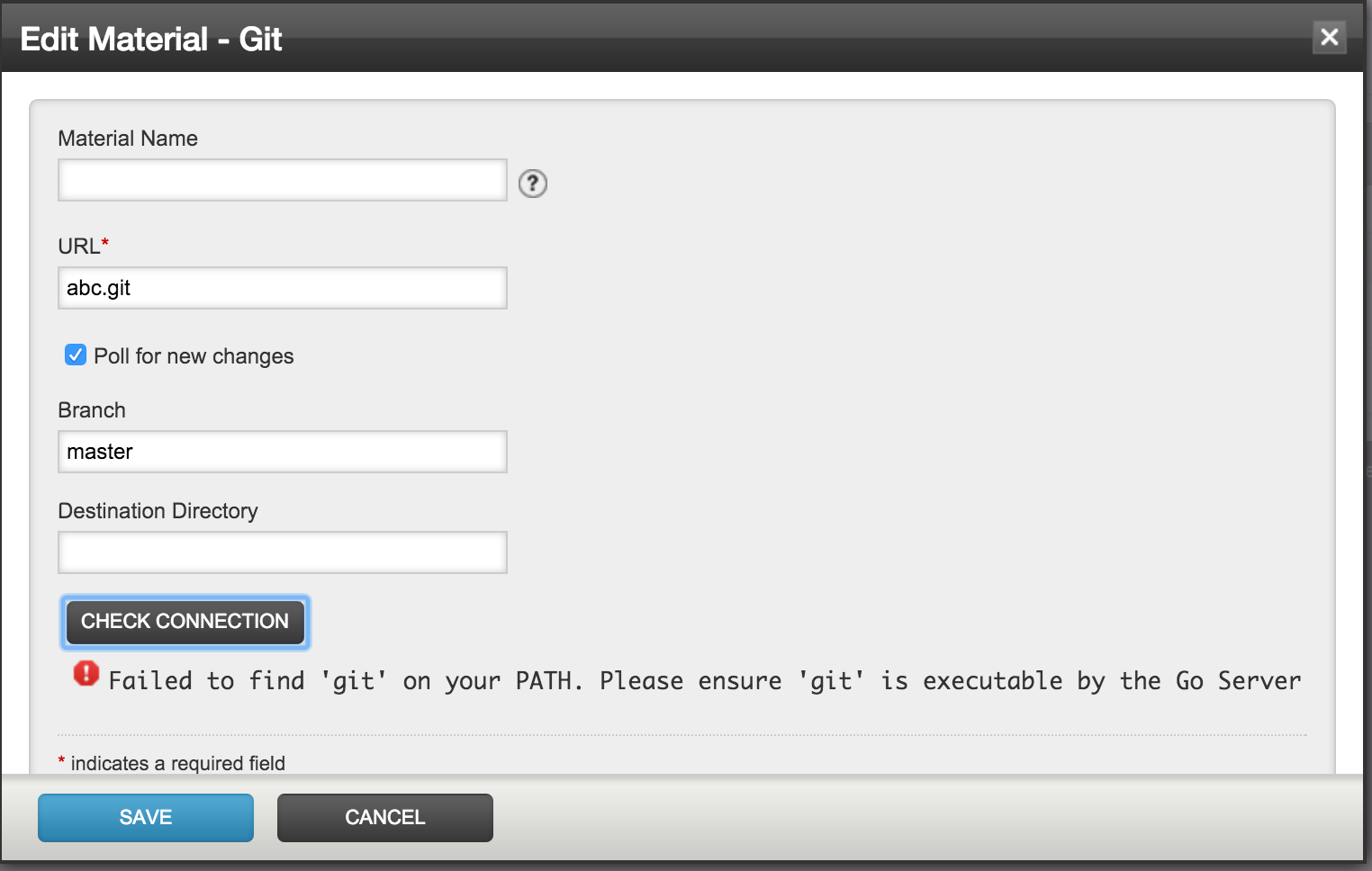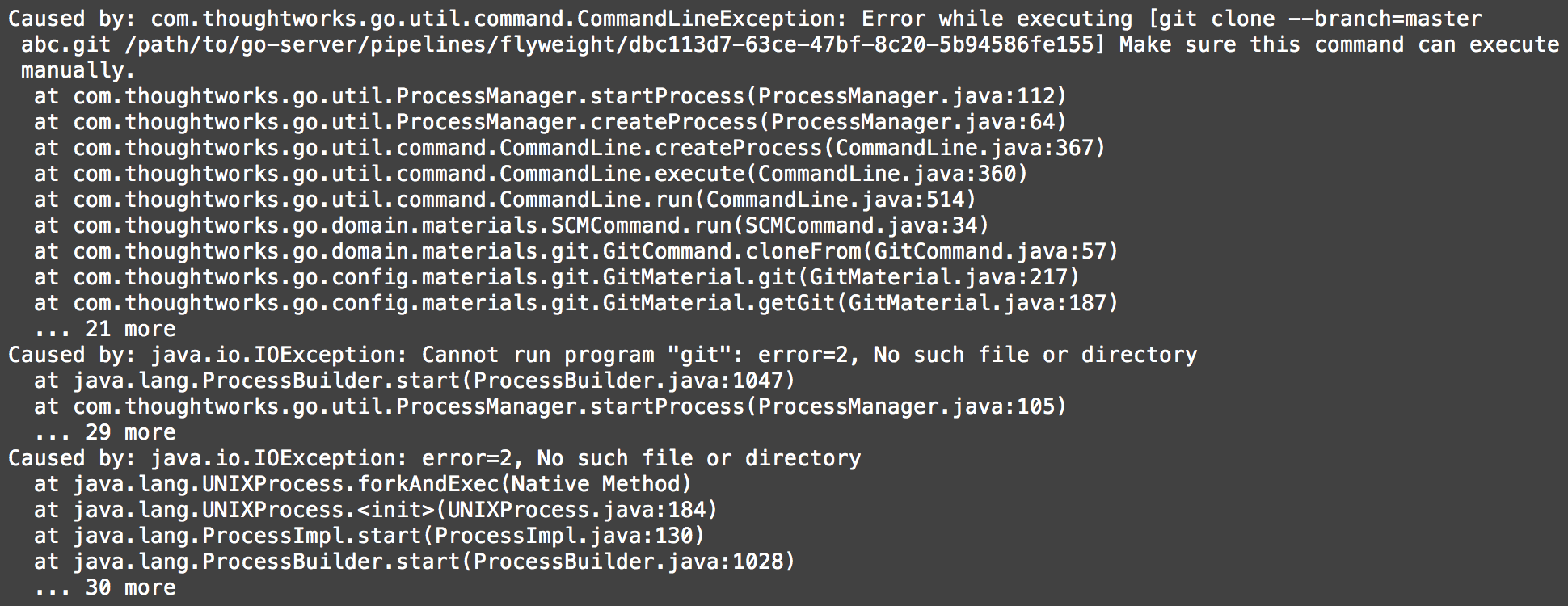Fixing common issues
This page is mainly for newer users of GoCD, to help with troubleshooting issues.
GoCD Agent not registering with the GoCD Server
This issue shows up either as an agent not showing up on the “Agents” page, or showing up with a status of “Missing”. If this happens, start troubleshooting by looking at the agent log files.
See the end of the installation documentation page for your operating system to find the location of the log files. There will be log files for the agent, the agent-bootstrapper and agent-launcher. Any errors at the end of these files might be interesting. Some common errors are:
-
Unable to reach the GoCD Server
This manifests itself as logs in go-agent-launcher.log with lines similar to this:
ERROR go.agent.launcher.ServerCall:69 - Couldn't access Go Server with base url: http://YOUR_SERVER:8153/go/admin/agent-launcher.jar: java.net.ConnectException: Connection refused ERROR go.agent.launcher.ServerBinaryDownloader:116 - Couldn't update admin/agent-launcher.jar. Sleeping for 1m. Error: java.lang.Exception: Couldn't access Go Server with base url: http://YOUR_SERVER:8153/go/admin/agent-launcher.jar: java.net.ConnectException: Connection refused INFO apache.commons.httpclient.HttpMethodDirector:438 - I/O exception (java.net.ConnectException) caught when processing request: Connection refused INFO apache.commons.httpclient.HttpMethodDirector:444 - Retrying requestThe problem here is that the agent cannot reach the server, either because of a problem with the network or because the ports used by the server are not accessible due to firewall restrictions. The GoCD server uses port 8153 by default over HTTP, but if you have configured a reverse proxy to terminate TLS, you should ensure the agent is configured with the correct protocol/host/port for the server.
-
Unable to connect - SSL handshake error or connection reset
This manifests itself as logs in go-agent-bootstrapper.out.log with lines similar to this:
180679 [main] ERROR com.thoughtworks.go.agent.launcher.ServerCall - Couldn't access Go Server with base url: https://YOUR_SERVER/go/admin/agent-launcher.jar: javax.net.ssl.SSLHandshakeException: Remote host closed connection during handshake java.lang.Exception: Couldn't access Go Server with base url: https://YOUR_SERVER/go/admin/agent-launcher.jar: javax.net.ssl.SSLHandshakeException: Remote host closed connection during handshake at com.thoughtworks.go.agent.launcher.ServerCall.invoke(ServerCall.java:78) at com.thoughtworks.go.agent.launcher.ServerBinaryDownloader.headers(ServerBinaryDownloader.java:130) at com.thoughtworks.go.agent.launcher.ServerBinaryDownloader.downloadIfNecessary(ServerBinaryDownloader.java:106) at com.thoughtworks.go.agent.launcher.AgentLauncherImpl.launch(AgentLauncherImpl.java:78) at com.thoughtworks.go.agent.bootstrapper.AgentBootstrapper.go(AgentBootstrapper.java:72) at com.thoughtworks.go.agent.bootstrapper.AgentBootstrapper.main(AgentBootstrapper.java:54) at sun.reflect.NativeMethodAccessorImpl.invoke0(Native Method) at sun.reflect.NativeMethodAccessorImpl.invoke(Unknown Source) at sun.reflect.DelegatingMethodAccessorImpl.invoke(Unknown Source) at java.lang.reflect.Method.invoke(Unknown Source) at com.simontuffs.onejar.Boot.run(Boot.java:306) at com.simontuffs.onejar.Boot.main(Boot.java:159) Caused by: javax.net.ssl.SSLHandshakeException: Remote host closed connection during handshake at sun.security.ssl.SSLSocketImpl.readRecord(Unknown Source) at sun.security.ssl.SSLSocketImpl.performInitialHandshake(Unknown Source) at sun.security.ssl.SSLSocketImpl.startHandshake(Unknown Source) at sun.security.ssl.SSLSocketImpl.startHandshake(Unknown Source) at org.apache.http.conn.ssl.SSLConnectionSocketFactory.createLayeredSocket(SSLConnectionSocketFactory.java:394) at org.apache.http.conn.ssl.SSLConnectionSocketFactory.connectSocket(SSLConnectionSocketFactory.java:353) at org.apache.http.impl.conn.DefaultHttpClientConnectionOperator.connect(DefaultHttpClientConnectionOperator.java:141) at org.apache.http.impl.conn.PoolingHttpClientConnectionManager.connect(PoolingHttpClientConnectionManager.java:353) at org.apache.http.impl.execchain.MainClientExec.establishRoute(MainClientExec.java:380) at org.apache.http.impl.execchain.MainClientExec.execute(MainClientExec.java:236) at org.apache.http.impl.execchain.ProtocolExec.execute(ProtocolExec.java:184) at org.apache.http.impl.execchain.RetryExec.execute(RetryExec.java:88) at org.apache.http.impl.execchain.RedirectExec.execute(RedirectExec.java:110) at org.apache.http.impl.client.InternalHttpClient.doExecute(InternalHttpClient.java:184) at org.apache.http.impl.client.CloseableHttpClient.execute(CloseableHttpClient.java:82) at org.apache.http.impl.client.CloseableHttpClient.execute(CloseableHttpClient.java:107) at com.thoughtworks.go.agent.launcher.ServerCall.invoke(ServerCall.java:55) ... 11 more Caused by: java.io.EOFException: SSL peer shut down incorrectly at sun.security.ssl.InputRecord.read(Unknown Source) ... 28 moreor this:
2986 [main] ERROR com.thoughtworks.go.agent.launcher.ServerCall - Couldn't access Go Server with base url: https://YOUR_SERVER/go/admin/agent-launcher.jar: java.net.SocketException: Connection reset java.lang.Exception: Couldn't access Go Server with base url: https://YOUR_SERVER/go/admin/agent-launcher.jar: java.net.SocketException: Connection reset at com.thoughtworks.go.agent.launcher.ServerCall.invoke(ServerCall.java:78) ...The problem here is that the agent is not able to connect securely to the server, which points to an invalid certificate or a certificate that the agent does not trust.
If you’re using full end-to-end transport security with a reverse proxy or load balancer terminating TLS, this error might mean that the server’s certificate has changed or that the agent’s configuration needs to be updated to trust the server’s current certificate.
-
Incompatible Java version
This manifests itself as logs in go-agent-bootstrapper.log with lines similar to this:
242 [main] INFO com.thoughtworks.go.util.PerfTimer - Performance: Downloading new admin/agent-launcher.jar with md5 signature: e9SXM6cdV5kSkpVEmymHIg== took 37ms Exception in thread "main" java.lang.reflect.InvocationTargetException at sun.reflect.NativeMethodAccessorImpl.invoke0(Native Method) at sun.reflect.NativeMethodAccessorImpl.invoke(NativeMethodAccessorImpl.java:57) at sun.reflect.DelegatingMethodAccessorImpl.invoke(DelegatingMethodAccessorImpl.java:43) at java.lang.reflect.Method.invoke(Method.java:622) at com.simontuffs.onejar.Boot.run(Boot.java:306) at com.simontuffs.onejar.Boot.main(Boot.java:159) Caused by: java.lang.UnsupportedClassVersionError: com/thoughtworks/cruise/agent/launcher/AgentLauncherImpl : Unsupported major.minor version 51.0 at java.lang.ClassLoader.defineClass1(Native Method) at java.lang.ClassLoader.defineClass(ClassLoader.java:643) at java.security.SecureClassLoader.defineClass(SecureClassLoader.java:142)The problem here is that the version of Java used by the agent is too old. In this example, Java 6 was used by an agent, with a
16.2.0GoCD server, which needs Java 7. -
Agent tokens have been invalidated or you are trying to switch to another server
You already have successfully enabled the agent on the server, but now the agent doesn’t show up anymore on the server.
go-agent.log reads like this:
java.lang.RuntimeException: org.apache.http.client.ClientProtocolException: The server returned status code 403. Possible reasons include: - This agent has been deleted from the configuration - This agent is pending approvalScenario 1: You have re-installed the server from scratch or cleaned up a few files on the server. Thereby you have invalidated the tokens of all agents and no agent can connect to the server anymore.
Scenario 2: You are trying to connect the agent to a different server. Of course, the agent’s token isn’t valid for the new server.
Unfortunately, the agent cannot simply drop the invalidated token, because it might be one of the other reasons above - and then dropping the token wouldn’t be a good idea.
Instead, you have to deleted the invalidated token manually. Find the agent’s config directory (/var/lib/go-agent/config by default under Linux) and delete the files
guid.txtandtoken.
Command not found (git, svn, mvn, ant or others)
This issue shows up in one of three ways as you can see below. The resolution
for all three issues is the same – to ensure that the PATH environment variable
is correct.
-
During “Check Connection”

This can also happen with other version control systems such as SVN, TFS, etc.
Resolution: Check the
PATHenvironment variable of the GoCD Server’s java process. Ensure that the directory that the command is available is in the list. On Windows, the procexp tool from Microsoft’s Windows SysInternals might be useful to check this. It shows per-process environment variables in an easy way. -
During material polling
Look for an error message at the bottom-right of any page, which looks like this:

Clicking on that shows an error like this:

The GoCD server log, go-server.log (location can be found at the bottom of the installation documentation page for your operating system) will have a message like this:

This can also happen with other version control systems such as SVN, TFS, etc.
Resolution: Check the
PATHenvironment variable of the GoCD Server’s java process. Ensure that the directory that the command is available is in the list. On Windows, the procexp tool from Microsoft’s Windows SysInternals might be useful to check this. It shows per-process environment variables in an easy way. -
During the running of a task, in the console output
This shows up as a message in the console output, like this:

This can also happen with other version control systems such as SVN, TFS, etc. It can also happen with any other command used in a task, such as Maven, Ant, Rake or even any other shell-script where it cannot be found in
PATH.Resolution: Check the
PATHenvironment variable of the GoCD Agent’s java process. Ensure that the directory that the command is available is in the list. On Windows, the procexp tool from Microsoft’s Windows SysInternals might be useful to check this. It shows per-process environment variables in an easy way.
Agent is not being assigned or “Nothing gets built”
This shows up as a pipeline which stays in the “Building” (yellow) state for a long time:

Click on the stage bar and then the job, to reach the console log, and you might see a build whose status is “Scheduled” with the agent status being “Not yet assigned”, like this:

Resolution: If this is happening, it means that a suitable agent has not been found for this job. The reasons for this can be:
-
No agent is available (free and not building). Check the “Agents” page to see if all agents are busy. If so, once one of them becomes free, then this build will start.
-
If you do see available agents, then check whether the job has resources defined in its config. If so, it means that the job is looking for an agent with those resources. Check the “Agents” page to see whether there are agents which have the resources needed by the job and are available (not building).
-
If the previous two options don’t solve the problem, check whether the pipeline is a part of an environment (in the “Environments” page or in the config). If it is, then any agent that can pick up a job from that pipeline needs to be a part of that environment as well.
GoCD SPA Pages - There was an unknown error performing the operation. Possible reason (timeout)
The GoCD SPA page periodically makes AJAX API calls to fetch the current state of the entity and refreshes the page, this is done to ensure the information on the page is not stale.
The AJAX API request has a timeout set to 5000 milliseconds, if the server does not respond within that duration the request is cancelled and an error is shown on the page.

Resolution: If this is happening, consider increase the timeout period by specifying the go.spa.timeout
Application not listening to port 8154 (HTTPS)
From GoCD 20.2.0 onwards, the GoCD server will no longer generate any self-signed SSL/TLS certificates or listen to port 8154 (HTTPS) by default.
From GoCD 20.5.0 the server no longer contains any functionality to configure TLS on the server.
Users are expected to terminate TLS elsewhere, for example using a reverse proxy or load balancer.
Versions between 20.2.0 and 20.5.0 allowed fallback to use previous configuration as a temporary measure. More information
can be found in issue #7872.
Port 8153 (HTTP) could not be opened
This issue shows up an error when starting GoCD Server:
Port 8153 could not be opened. Please Check if it is available
This could be happening if port 8153 is already used. In order to change default ports, set the system property cruise.server.port to an appropriate value in the file wrapper-properties.conf on the GoCD server. See the installation documentation for the location of wrapper-properties.conf file.
Expand the shell profile
GoCD agents use a restricted shell profile. The go user profile is not sourced when the agent starts or a shell command is run. This can result in the GoCD agent being unable to run applications installed in non default locations.
To expand the PATH variable, the wrapper-properties.conf file should be updated to include the required PATH locations. The example below shows how to expand the PATH to support rbenv.
# On Unix/Linux/macOS. Note that you must use %PATH%, and not $PATH, as you'd normally do on this platform
set.PATH=var/go/.rbenv/plugins/ruby-build/bin:/var/go/.rbenv/shims:%PATH%